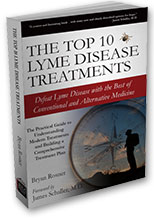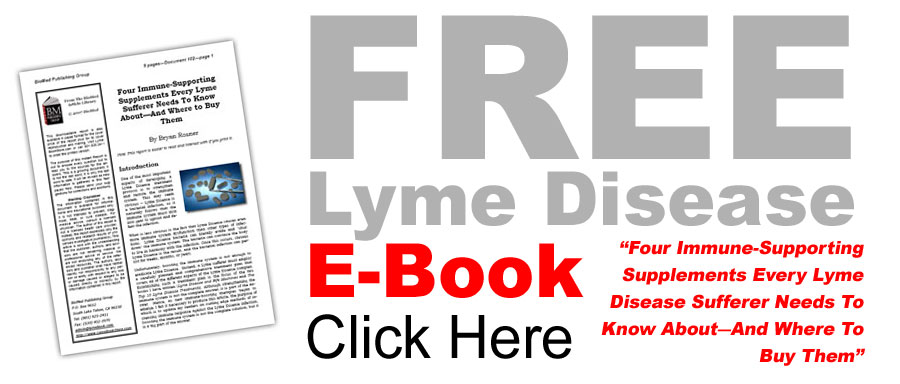| Lyme Disease: The Bacterial Next-Door Neighbor
Please send any
comments or questions.
 In
this video, created March 25, 2010, I ask the question: Can you get rid
of Lyme disease quickly, or is it a more long-term, sustainable
pursuit? In
this video, created March 25, 2010, I ask the question: Can you get rid
of Lyme disease quickly, or is it a more long-term, sustainable
pursuit?
Some Lyme
disease doctors have said that treating Lyme disease is a marathon,
not a sprint. I think these words of wisdom are precisely correct. In
treating Lyme like a sprint, people tend to spend all their money fast
at exotic medical clinics that promise false hope and use 2-4 week
procedures. Treatments like this, including IV antibiotics, also drive
the Lyme disease bacteria into cyst
form and L-form, which are much more difficult to treat.
Sustainable treatments usually include those that
are affordable and non-toxic and can be done in the privacy of your own
home, on your own time. Here is
one example of a sustainable treatment. For further explanation of
why sustainable treatments are necessary, see the below excerpt from The
Top 10 Lyme Disease Treatments, a book I published on the
topic.
 -
Excerpt - -
Excerpt -
Sustainable Lyme Disease
Treatment:
Time, The Treatment of all Treatments
From the book, The
Top 10 Lyme Disease Treatments
If I were forced to choose one treatment that stands out above the others (even with recognition of the need for individualized treatment planning), it would be time. Is time a treatment, you ask? Yes, it is. It has been said that "Time heals all wounds." With regard to Lyme Disease recovery, that famous statement is more than just a figure of speech—it is a reality. Over time, assuming that you use some of the right treatments and avoid most of the wrong treatments, you will get better and better and better. Time is the currency by which Lyme Disease treatment is measured. Recovering from chronic Lyme Disease typically takes from 6 months to 5 years.
Why is the recovery process so long? The best answer is simply that at the present time, Lyme Disease remains a very difficult illness to beat. While the treatments in this book often do lead to substantial healing progress, their downfall is that they require a lot of time. If given enough time, in my opinion, remission from Lyme Disease is possible in even the worst cases. But unfortunately, success is not possible in a short period of time. Some of the specific reasons for the long recovery process include:
-
Every effective Lyme Disease treatment relies to some extent on the bacterial lifecycle process. Most bacterial infections that humans acquire,
such as strep throat, have very short lifecycles (1 minute to 10 days), so effective treatment can be accomplished in a short amount of time. Lyme Disease bacteria, on the other hand, have a very long lifecycle. Medical textbooks describe the Lyme Disease lifecycle as being between three and 30 days long. New research indicates that some parts of the lifecycle are six months to a year long, or even longer. Because successful treatment requires passing through at least several bacterial lifecycles, the healing process can require several years. One of the components of the long bacterial lifecycle is the process by which cyst-form bacteria convert to active, spirochete-form bacteria, which can be quite drawn out.
-
Lyme Disease bacteria group together inside the body in dense colonies. In some cases, lone bacteria may be isolated and infect cells of the body in low numbers, but in most cases, the bacteria form tightly-packed colonies that have multiple layers of bacteria. Treatments in use at any given time will only affect outside layers of bacterial colonies, while inside layers remain safe and shielded. This is one of the characteristics of Lyme Disease that make it so insidious and treatment-resistant. Because bacteria group together in colonies that have multiple layers, Lyme Disease treatment is similar to peeling layers off an onion—or more accurately, peeling layers off a Lyme Disease colony. It takes time to remove each layer, and a full recovery is only possible after all layers of colonies have been removed. In theory, it may be possible to utilize a treatment that kills the entire colony at one time. However, there are a few serious obstacles that stand in the way of such an approach:
a. First, such a treatment would likely be so toxic that it kills or causes severe damage to the patient him/herself. For example, extremely high temperatures (140° F and above) are known to degrade entire bacterial colonies, but obviously these temperatures would also kill a human being. Mildly increasing body temperature (i.e., to 100° F), while safe for the patient and somewhat helpful for killing bacteria, is not sufficient to eradicate entire colonies. Similarly, certain poisons or drugs at high doses may wipe out entire colonies but would also wipe out the patient.
b. Second, killing Lyme Disease bacteria results in herx reactions caused by circulating bacterial byproducts which lead to symptoms of immune system activation and inflammation. In moderation, these reactions are tolerable and even help the recovery process. In excess, they can be very dangerous or even fatal. If all the bacteria in the body were killed at one time, the resultant herx reaction may be so intense as to kill the patient.
-
Part of the reason that the Lyme Disease infection is able to persist chronically in the body is that conditions in the body are favorable to chronic infection. Toxicity, compromised immunity, obesity, poor diet, excessive stress, inadequate exercise, and other factors can lead to decreased ability for the body to ward off dangerous bacterial infections. “Bioterrain” is the word that describes the tissues throughout the body with respect to their affinity for accumulating toxins and harboring infections. Healthy bioterrain has a low level of toxicity, sufficient oxygen transport, healthy blood flow, and balanced immune activity. Lyme Disease bacteria will have a much more difficult time establishing infection in healthy bioterrain. In contrast, unhealthy bioterrain is characterized by low oxygen supply, deranged immune function, poor circulation, and the presence of dangerous, immunosuppressive toxins (such as mercury). Chronic bacterial infections thrive amid unhealthy bioterrain. To eliminate chronic Lyme Disease, unhealthy bioterrain must be converted to healthy bioterrain. This process does not happen overnight. It requires extensive and committed lifestyle changes and lots of time. Diet must be cleaned up, detoxification must be undertaken, an exercise program must be utilized, and various other steps must take place. A speedy recovery from Lyme Disease is difficult (if not impossible) due to the slow process by which unhealthy bioterrain is converted to healthy bioterrain.
As you can see, there are some very profound reasons why the Lyme Disease recovery process is long. In the future, medical research may lead to a faster solution. History has taught that difficult challenges in treating disease can be obliterated as the result of a single breakthrough or discovery. Hopefully, such a discovery will occur in our lifetimes and render the Lyme Disease recovery process much shorter. Until this happens, the long recovery process is simply an unavoidable reality. This lengthy recovery process can be expected regardless of which anti-Lyme therapies you choose to use.
Instead of asking the pie-in-the-sky question of how we can shrink the recovery process from several years down to a couple weeks, it is more realistic for us to ask how we can optimize treatment planning and utilization to take as much time off the process as possible, and to make the process as convenient, comfortable, and affordable as possible. These are some of the goals of this book. The aim is not to replace the treatment guidelines set forth in my first book, but instead, to optimize and enhance them, with the ultimate goal of reducing the recovery time frame as much as possible and minimizing symptoms along the way. A friend and fellow research partner would always refer to the goal of shortening the recovery time as “shortening the runway.”
It is important not to overlook the significance of time in healing chronic Lyme Disease. It takes the body a long time to develop chronic illness, and it will take a long time for the illness to be healed. Understanding and accepting the lengthy recovery process will prevent you from becoming discouraged. Additionally, because the recovery process is often not smooth but instead turbulent (much like a roller coaster ride), it is even more valuable to understand this at the outset. Seasonal symptom flareups are common (especially in spring and fall) and if these are not expected, they can be cause for doubt, discouragement, and undue stress.

|


